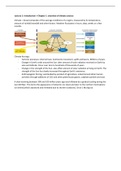Samenvatting
Samenvatting midterm: Quaternary Climate and Global Change
- Instelling
- Universiteit Utrecht (UU)
- Boek
- Earth\'s Climate
Complete samenvatting voor de midterm met de hoorcolleges en hoofdstukken van het boek. Hoorcollege 1 t/m 13. Hoofdstuk 1,2,3,8,9,10,11,12,13,14,15,16,17,18,19,20
[Meer zien]














